Summer is nearly here, and the 2025 field season is shaping up to be busy for marine debris removal in Alaska.
Due to Alaska's extreme weather conditions and remote locations, working in the field during the winter in most places is nearly impossible. That means that field activities must happen in a defined “field season,” sometime between April and October for most of the state. Even during the summer season, completing field activities is complex and requires lots of preparation. It’s essential to “gear up” and ensure everything is prepped and planned so that no time is wasted during the short season.
Groups around the state are strategizing and working together to take full advantage of the season, leaving cleaner and healthier beaches. As our partners prepare themselves and their teams, they have three critical questions in mind. Read on to learn more about how our partners in Alaska “gear up.”
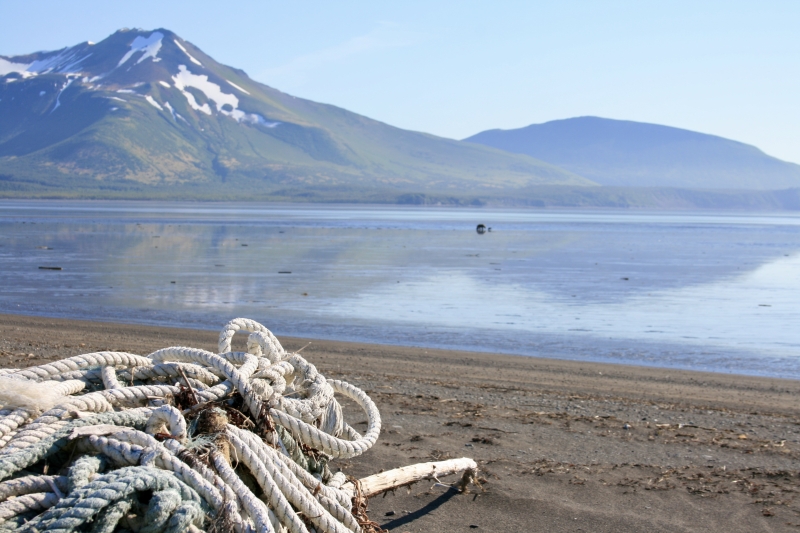
How to get there?
Due to Alaska’s sheer size and rugged landscape, getting to cleanup locations is rarely as simple as hopping in the truck and driving to the beach. Alaskan communities are not always on the road system, meaning that there may be roads within the town, but those roads do not spread to nearby beaches or other communities. A great example of this is the state capital of Juneau, the third largest city in the state, which can only be reached by boat or plane. So, how does the team get to the cleanup site?
Day Trips
Day trips are typically hosted in locations that can be reached by all-terrain vehicles (ATVs) or small boats. This year, the Yakutat Tlingit Tribe, in partnership with the NOAA Marine Debris Program, will conduct shoreline cleanups, removing derelict fishing gear, consumer debris, and more. The team is targeting beaches that can be difficult to reach. Some locations require hour-long small boat rides, while others require ATVs and boats combined. These day trip cleanups will benefit the local community by creating healthier ecosystems for subsistence fishing.
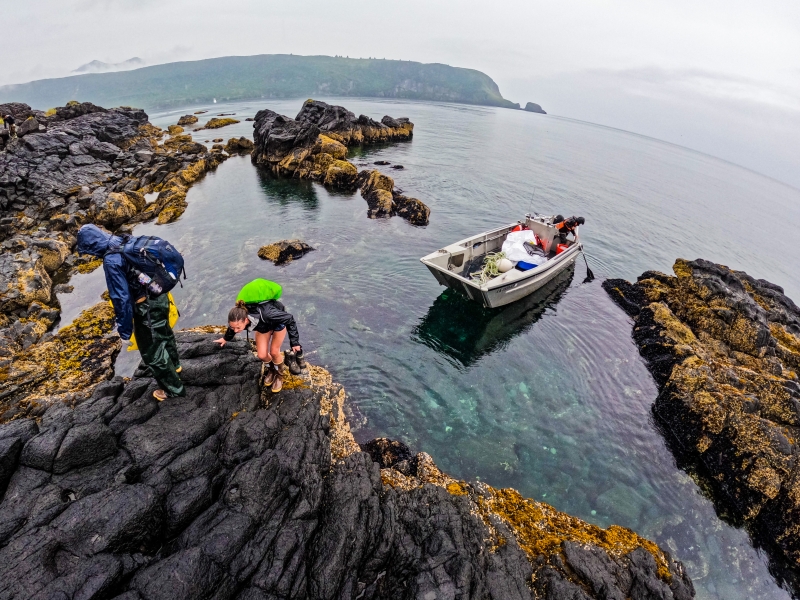
Expedition Trips
Expedition trips are hosted in remote locations for extended periods of time. Crews sleep in tents on the beach or vessels anchored offshore. Transportation methods include boats, ATVs, and helicopters. With support from the NOAA Marine Debris Program, Gulf of Alaska Keeper will be working on Montague Island in Prince William Sound, an incredibly rugged, uninhabited location that requires an expedition trip. The island is a hotspot for marine debris, such as derelict fishing gear and creosote-treated lumber. During this expedition, the crew will live on boats moored off the interior coast of Montague Island for weeks at a time. Each day, crew members will be flown to the outer coast of the island by helicopter to remove debris from the beaches. This debris will be picked up later by helicopter and transported to a barge that will take it to Anchorage for disposal.

What to pack?
In Alaska, the summer season consists of long days where crews are immersed in nature with limited access to resources. When packing to clean up marine debris in Alaska, it's important to make sure the crew has everything they need for various situations. So, what does the team pack for?
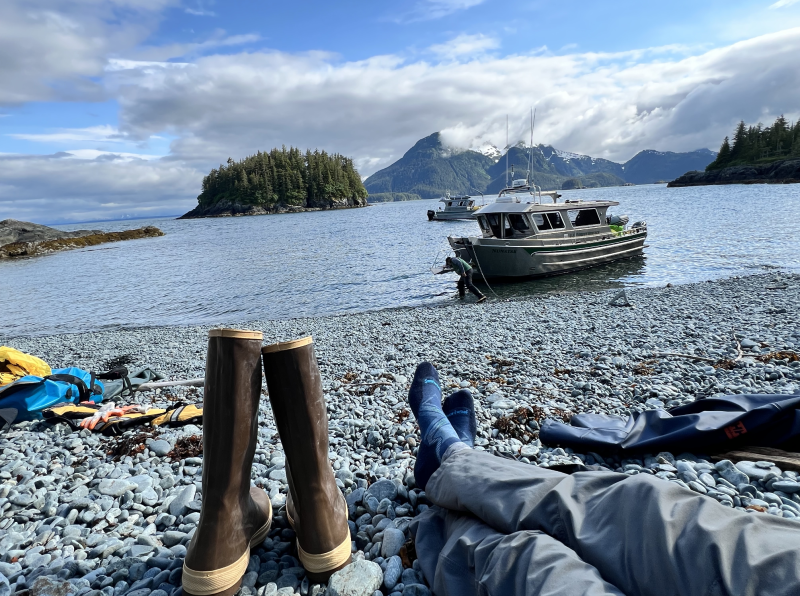
Pack for the weather
The weather in Alaska can be unpredictable, so it’s essential to pack for all possibilities. Layers are a must, including lightweight jackets, fleeces, hats and gloves, and rain gear. Even in August, the weather can go from sunny and warm to rain, wind, and clouds - even on the same day. The Ocean Plastics Recovery Project team knows the importance of rain gear since they work on Prince of Wales Island, which gets up to 200 inches of rain per year. With support from the NOAA Marine Debris Program, this team is removing marine debris from remote shorelines in Southeast Alaska. Having the right gear allows the team to persevere through the changing conditions in this area.
Pack for wildlife
Alaska is full of incredible wildlife, from eagles to whales. The right gear is important for any wildlife encounters. Crews bring binoculars to spot wildlife, for their protection, and to prevent any disturbance to wildlife. Bear spray is also a necessity for any cleanup, since they are a constant potential visitor at cleanups across most of the state.
Pack for the work
Marine debris removal, especially with large debris, requires special equipment, in addition to gloves and bags. The City of Chevak, with support from the NOAA Marine Debris Program and the University of Alaska Fairbanks, will need ice picks, shovels, chainsaws, axes, and heavy-duty plastic sleds to transport collected debris out of the area once the ground has refrozen in the winter months. Teams also pack lots of snacks to fuel a hard day's work!
Where to dispose of marine debris?
Disposing of marine debris in Alaska is especially difficult because of the cost, timing, and location. How marine debris will be disposed of and the logistics for transportation need to be considered during the cleanup's planning stages, well in advance of heading into the field. So, where does the marine debris go after the cleanup?
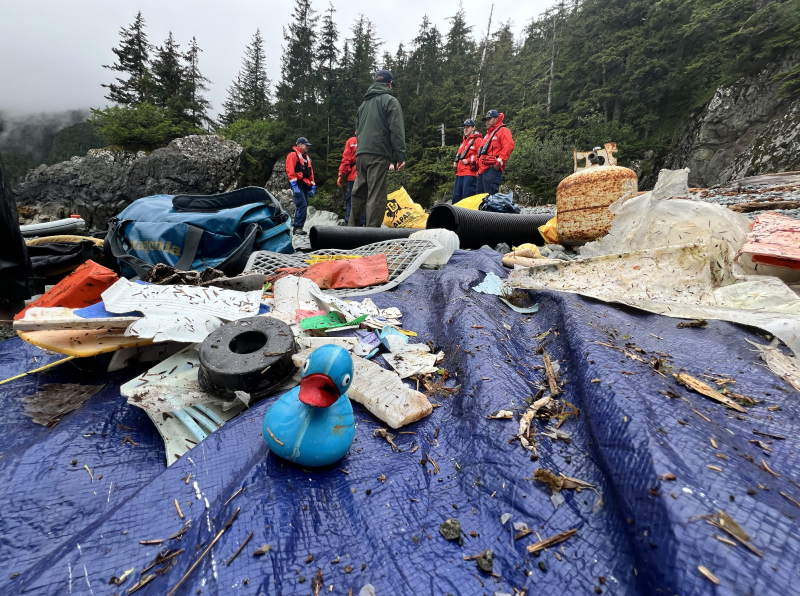
Reuse or Recycling
If possible, it is always preferred to reuse or recycle marine debris rather than bring it to the landfill. Some landfills in Alaska are unable to accept marine debris as they can use up space needed by the local community. Reuse helps to save space and benefits people who can find uses for the items recovered during cleanups. With support from the NOAA Marine Debris Program and the University of Alaska Fairbanks, Drifter’s Fish, based in Cordova, will send the debris collected to Seattle to be recycled. Local fishermen with years of experience navigating the Copper River Delta will lead the removal of marine debris in difficult-to-navigate waters, creating the best environment for success. Recycling infrastructure that can accept marine debris in Alaska is still in the beginning stages and only available in some places. However, projects throughout the state are working to find new opportunities that create new products out of recycled debris.
Local or Hub Landfill
Most times the simplest way to dispose of marine debris is at a landfill close to the cleanup site. However, space can be a limiting factor. The closest landfill is often in a small nearby community that likely cannot accept the large amount of debris collected. Some cleanups may be able to access a “hub” landfill that serves larger communities. The Native Village of Goodnews Bay, in partnership with the NOAA Marine Debris Program and the University of Alaska Fairbanks, will work with the community to clean up the debris on their local beaches, which will be disposed of in the local landfill.
Transporting to Other States
When local and hub landfills cannot accept the marine debris collected, it needs to be transported to bigger facilities in the continental United States, or the “Lower 48”. This is sometimes done through “backhaul,” or transporting debris back to the Lower 48 on ships that carried goods up to Alaska, but are returning without any cargo. Once the debris reaches the continental United States, it is sent to landfills with more space or goes to recycling facilities. Backhauling debris is common in the Bering Sea region and will be utilized this summer. Zender Environmental will clean up marine debris from the destructive Typhoon Merbok that hit western Alaska in 2022 with support from the Hurricane Response Marine Debris Removal Fund, a partnership between the NOAA Marine Debris Program and National Fish and Wildlife Foundation. By targeting debris in critical harvesting habitats in 18 Alaska Native communities, the team hopes to create a healthier and safer environment and will work to support local communities through employment and debris removal while building capacity for the future.
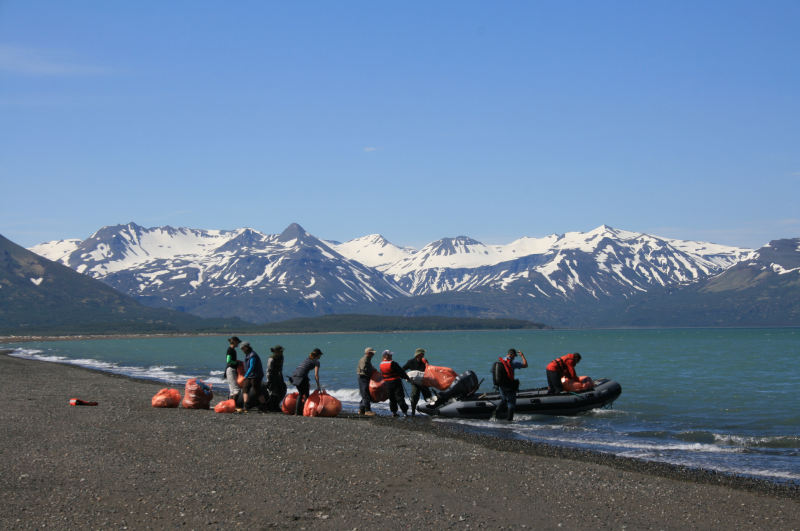
Removing marine debris in Alaska can be challenging and requires lots of preparation and planning from our partners. Organizations and our partners within the state of Alaska continue to work diligently to create a better environment and economy. The impacts of marine debris on Alaska’s ecosystems and economy drive these partners to make a difference for communities. By removing marine debris, these groups create new job opportunities for residents, healthier ecosystems for subsistence fishers, and future capacity for more work like this.
